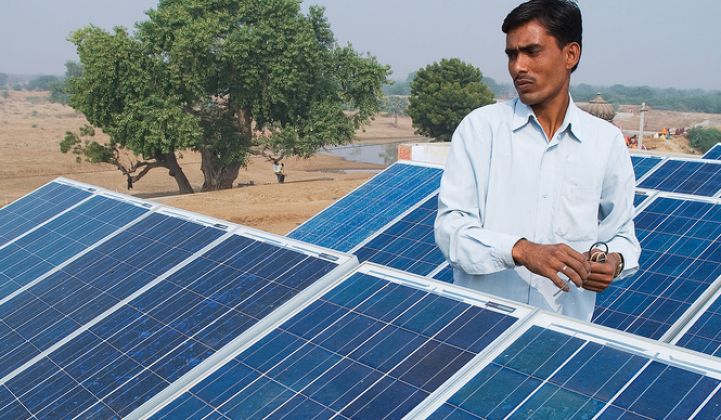India is going to fall short of its ambitious 2022 renewable energy target.
But even getting three-quarters of the way there would be a noteworthy achievement, say analysts at Wood Mackenzie Power & Renewables.
India is aiming to install 100 gigawatts of solar and 75 gigawatts of wind by 2022. Despite significant cost reductions in both technologies and strong government support in the country, Wood Mackenzie only expects India to get to 76 percent of this target, the firm said this month.
Wood Mackenzie solar analyst Rishab Shrestha said recent auction cancellations in India risk jeopardizing investor confidence, while the imposition of various duties on equipment are bumping up solar prices.
As a result, he said, cash-strapped state distribution companies are dragging their feet over approving new solar projects. The Wood Mackenzie forecast echoed views among Indian analysts.
In a note published this month, India Ratings & Research said: “The recent scrapping of solar auctions around tariff concerns can derail the Ministry of New and Renewable Energy target to achieve 100 gigawatts of solar capacity by FY22.”
India’s solar auction target for the 2019 financial year may also be missed on account of frequent changes in the implementation of safeguard duties, apprehensions about grid connectivity, and land-acquisition-related bottlenecks, the analyst firm said.
Finally, it noted, the depreciation of the rupee against the dollar could pose a threat to the economic viability of Indian solar tariffs. These headwinds follow a period of galloping growth for renewables in India.
Since 2014, India’s wind and solar capacity has almost doubled, topping 61 gigawatts this year. Growth has been driven by auctions that have forced costs down.
Over the next half decade, Shrestha said, capital costs for solar are expected to fall by a further 31 percent, while wind could see a 23 percent drop. “This trend will only continue as new generation technologies replace old ones."
Wood Mackenzie forecasts that non-hydro renewables will make up 13 percent of India’s generation mix by 2023, mostly taking market share from coal. And although the country will likely miss its 2022 renewables target, the mid- to long-term outlook remains good.
Initial policy discussions on India’s 2030 renewables target have already “shed a positive light on renewables,” Shrestha said. “Improving grid flexibility through storage and flexible power generation will be extremely crucial in achieving high levels of renewable penetration.”
Economic competitiveness, technological maturity and financially healthy offtakers will provide a solid base for renewable capacity to meet electricity demand growth, he said.
As a result, by 2040, India is forecast to increase its renewable capacity by around seven times, to 384 gigawatts.
By then, India’s non-hydro renewables mix will provide one-fifth of the country’s generation capacity and could include a diverse array of technologies including offshore wind, hybrid projects, floating solar and distributed PV, Shrestha said.
Despite this, coal is set to remain India’s dominant source of power for the foreseeable future, delivering around three-fifths of the country’s electricity by as far out as 2040. Coal consumption is currently at its peak in India.
Pralabh Bhargava, coal principal analyst at Wood Mackenzie, said India’s coal industry is struggling to keep up with demand and the country had raised imports from 158 million tons to 164 million tons in 2018.
This could increase further, by up to 4 million tons, as coal stocks at Indian power plants and Coal India Limited are at historically low levels, Bhargava said.
India's spot market prices for coal and power are expected to remain strong in the coming months as continuous industrial production growth is pushing demand, while supply remains tight, he said.
Demand for imported coal was forecast to remain high until early next year, he said, as utilities and industrial consumers competed for supply. Industry demand for coal has been bolstered by a 7 percent increase in industrial output this year, Bhargava said.
“In the steel sector, India's hot metal production was up 10 percent year-on-year for January to August,” he noted. “With limited domestic upside in metallurgical coal production, steelmakers relied more on imported coking coal.”




